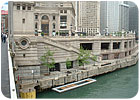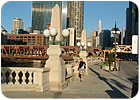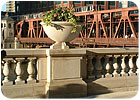
Wacker Drive, an historic 1920’s two-level roadway that travels alongside the main branch of the Chicago River, was recently reconstructed for both practical and aesthetic reasons.
The stonework seen along Wacker Drive in Chicago, IL, an historic 1920’s two-level roadway that travels alongside the main branch of the Chicago River, was recently restored for both practical and aesthetic reasons. The architect of record, DLK Architects of Chicago, worked in conjunction with the Chicago Department of Transportation (CDOT) engineering teams and other consulting architects to select Crown Silver Buff limestone from Indiana Limestone Co. of Oolitic, IN, and Carnelian granite from Cold Spring Granite Inc. of Cold Spring, MN, to match the existing material on site.
“The reconstruction at Wacker Drive was required because the existing infrastructure was deteriorating and the geometrics and lighting of the existing roadway didn’t meet current guidelines for roadway safety,” said architect Charlie Friedlander of DLK Architects.

The stonework present features an Indiana limestone exterior facade and a Carnelian granite base in a few different finishes to match various conditions.
Chicago-based Johnson Lasky Architects, an architectural firm specializing in historic preservation, was in charge of locating a new stone to match the existing material on Wacker Drive. The restoration team worked with Cold Spring Granite, and after extensive research, site visits and analysis of the original material’s color, finish and weathering, several options were developed and presented.

Decades of exposure to harsh climates had taken their toll on the structure, and therefore stone restoration was a large part of the project.
The stonework includes a Crown Silver Buff limestone exterior and a Carnelian granite base in a few different finishes to match various conditions. “The finishing affects the color of the stone, so that too is a consideration when selecting a specific material,” the architect explained.
One challenge, according to the architect, pertained to the reuse of existing stone and its integration with new stone assemblies. “Another challenge was to coordinate all the stone attachment methods with the structural assembly,” he said. “We were fortunate to have really good stone contractors, Fred Berglund and Sons, who reinstalled the facade running from Michigan Ave. to Wasbash Ave., and W.R. Weis who installed assemblies in the tangent blocks.”

The sidewalk width was increased on the riverside to allow pedestrians to enjoy views of the river while walking along Wacker Drive.
The client, the Chicago Department of Transportation, deemed the project a success. “The project was executed ahead of the scheduled timeline and on budget,” Friedlander said. “The reconstruction greatly improved the uniformity of street lighting and sight distance along the roadway, and from a driver’s standpoint, it is an easier and safer road to drive.”

Additionally, new ornamental planters were installed along the streetscape.
“Natural stone is durable,” the architect said. “There’s a reason why it was used in the original construction. You can learn a lot from taking old buildings apart. You know why they stood there for 100 years.”
Wacker Drive roadway
Chicago, IL
Architect of Record:DLK Architects, Chicago, IL; Johnson Lasky Architects, Chicago, ILStone Suppliers:Cold Spring Granite Inc., Cold Spring, MN (granite); Indiana Limestone Co., Oolitic, IN (limestone)
Stone Installer:W.R. Weis Co., Inc., Chicago, IL
General Contractor:Walsh Construction Co.
Stone Restoration Contractor:Fred Berglund and Sons, Chicago, IL